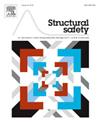昂贵计算机模拟器的响应概率分布估计:使用高斯过程回归的贝叶斯主动学习视角
IF 6.3
1区 工程技术
Q1 ENGINEERING, CIVIL
引用次数: 0
摘要
在输入随机变量的情况下,计算机模拟器响应概率分布的估计是许多领域的一项重要任务。然而,在保证精度的情况下实现这一任务仍然是一个开放的计算挑战,特别是对于昂贵的评估计算机模拟器。在这项工作中,提出了一个基于高斯过程(GP)回归的贝叶斯主动学习视角来解决这一挑战。首先,响应概率分布的估计在概念上被解释为贝叶斯推理问题,而不是频率推理问题。这种解释提供了几个重要的好处:(1)它量化和传播离散误差的概率;(2)它结合了计算机模拟器的先验知识,(3)它能够有效地将解决方案中的数值不确定性降低到规定的水平。然后利用GP回归实现了概念贝叶斯思想,在GP回归中,我们以半解析形式导出了响应概率分布的后验统计量,并提供了数值解方案。在实际贝叶斯方法的基础上,进一步提出了一种估计响应概率分布的贝叶斯主动学习(BAL)方法。在这种情况下,关键的贡献在于主动学习的两个关键组成部分的发展,即停止准则和学习函数,利用后验统计的优势。通过5个数值算例的经验证明,所提出的BAL方法能够有效地估计出响应概率分布,并具有理想的精度。本文章由计算机程序翻译,如有差异,请以英文原文为准。
Response probability distribution estimation of expensive computer simulators: A Bayesian active learning perspective using Gaussian process regression
Estimation of the response probability distributions of computer simulators subject to input random variables is a crucial task in many fields. However, achieving this task with guaranteed accuracy remains an open computational challenge, especially for expensive-to-evaluate computer simulators. In this work, a Bayesian active learning perspective is presented to address the challenge, which is based on the use of the Gaussian process (GP) regression. First, estimation of the response probability distributions is conceptually interpreted as a Bayesian inference problem, as opposed to frequentist inference. This interpretation provides several important benefits: (1) it quantifies and propagates discretization error probabilistically; (2) it incorporates prior knowledge of the computer simulator, and (3) it enables the effective reduction of numerical uncertainty in the solution to a prescribed level. The conceptual Bayesian idea is then realized by using the GP regression, where we derive the posterior statistics of the response probability distributions in semi-analytical form and also provide a numerical solution scheme. Based on the practical Bayesian approach, a Bayesian active learning (BAL) method is further proposed for estimating the response probability distributions. In this context, the key contribution lies in the development of two crucial components for active learning, i.e., stopping criterion and learning function, by taking advantage of the posterior statistics. It is empirically demonstrated by five numerical examples that the proposed BAL method can efficiently estimate the response probability distributions with desired accuracy.
求助全文
通过发布文献求助,成功后即可免费获取论文全文。
去求助
来源期刊

Structural Safety
工程技术-工程:土木
CiteScore
11.30
自引率
8.60%
发文量
67
审稿时长
53 days
期刊介绍:
Structural Safety is an international journal devoted to integrated risk assessment for a wide range of constructed facilities such as buildings, bridges, earth structures, offshore facilities, dams, lifelines and nuclear structural systems. Its purpose is to foster communication about risk and reliability among technical disciplines involved in design and construction, and to enhance the use of risk management in the constructed environment
 求助内容:
求助内容: 应助结果提醒方式:
应助结果提醒方式:


